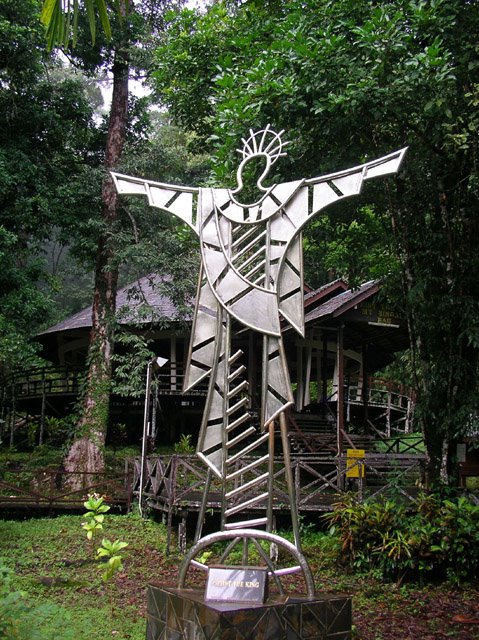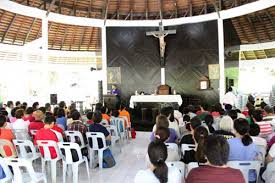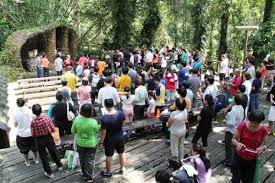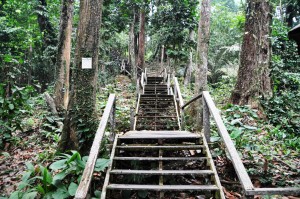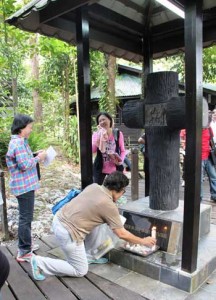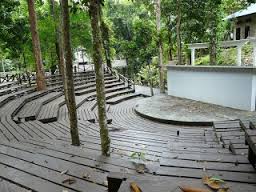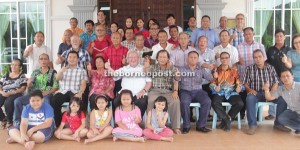The human spirit is the lamp of the Lord, searching every inmost part. [Proverbs 20:27, NRSV]
[L] The baruk-shaped Christ the King Chapel; [M] Inside the chapel. [R] The amphitheatre; [R] A gathering at the Marian Shrine.
To celebrate the “Day of the Laity” under the Kuching archdiocesan programme for the celebration of the Great Jubilee in 2,000, we spearheaded a committee for, amongst other things, a day of recollection. To facilitate the day’s proceedings, a book was published entitled “The Ministry of the Laity” which featured nine articles from lay people across the wide spectrum of the local faith community who were involved in different areas of communal life. We wrote in the Introduction:
- “Acting as adults ought to, they have voluntarily taken up responsibility for the Church, by applying their talents both for building up the faith community and for bearing witness to the love of Christ in the world.”
One of the nine articles collected in that small volume is entitled “Community-Project – the Singai Spirit”, written by none other than Vincent Eddy Ak. Sireng, the CMPC Chairman. In our editorial introduction to Vincent’s piece, we wrote:
- “It is no exaggeration to say that, had it not been for the incredible dedication, hard work and perseverance of the Bidayuh community in the Singai area, the CMPC project would just be another “wishful thinking”. Thanks to some profoundly inspired lay leaders who lead by example, the local community has been galvanized into the most incredible force of sustained gotong-royong this Archdiocese has ever witnessed. Their effort is nothing short of awe-inspiring. The CMPC at Singai is now a busy pilgrimage centre for pilgrims from far and near. It is an example of what the laity are capable of when the human spirit cooperates with the Holy Spirit. This sharing epitomizes the correct spirit of lay commitment without counting the cost. It preaches perseverance even when help is scarce and unfair criticisms are plenty.”
Vincent’s article is reproduced below:
… I am privileged to have been given this honour to share my inspirations and experiences relating to a project that has been with me literally “when I sleep and when I am awake, when I sit and when I stand” for a number of years.
I have been very privileged in that eight years ago today, Fr. Sepp, who was about to return to his home country, Austria, after completing a tour of duty in Sarawak, handed over the task of overseeing the construction and completion of the CMPC to me. At the time, the task seemed impossible, the problems insurmountable. Just on one item alone, namely, the financial costs, the problem seemed too daunting: there was only RM15,000.00 in the account then, and the whole project could cost anywhere around Ringgit Malaysia two million! This cost would be substantially reduced of course, if we undertook the construction work ourselves. But that meant we needed a dedicated committee to mobilize the people on gotong–royong. Can we find such a committee? How are we going to be able to carry all those building materials to the site way up on the Mount Singai, going through a trek and climbing a steep mountain? How are we going to get the people to cooperate in such a seemingly impossible assignment? And even if the people were to agree initially, will they persevere? And where will the rest of the funds come from, which is still in the tune of more than RM1 million after deducting free labour charges through gotong–royong? These and many other questions gave me nightmares. The task before me truly seemed all but impossible. So, at first, I turned down Fr. Sepp’s request that I took on the project. Later, on further reflections, I finally accepted the task upon the understanding that, however monumental and intimidating the task might seem, it was my duty to make my contributions to the Church and to leave the rest to God.
At that time, the CMPC featured only a small chapel, a shrine to Our Lady, a hostel and a living quarter for priests. Today, it is an impressive Centre, complete with a Church, a Grotto to Our Lady, lots of hostels, a utility hall and living quarters. All these are supplied with gravity pipe water and connected to a generator. Pilgrims can meditate on the Stations of the Cross along the climb up which is now made so much easier by belian walkways and platforms erected over the steepest sections. These days, Holy Mass is celebrated at the Centre regularly and people from throughout the Archdiocese and beyond go there every week to pray, meditate or to attend Mass.
My experience has been that God works in strange but sure ways. The construction of the CMPC has committed and mobilised many people. It is indeed a showcase, if you will, of gotong royong at work which has mobilised the whole community of the Catholics in the Archdiocese as well as from outside. Fromn the Archbishop, the parish and associate priests, the religious sisters, the Parish Councilors, members of the CMPC Building Committee, to the faithful from all the 8 kampongs in Singai as well as from Jagoi, Krokong, Serembu, Bratak, Batang Kayan, and Lundu, all have contributed in different forms. Catholics through out the world, from West Malaysia, Singapore, Australia, New Zealand, England, Ireland, Ausdtria to Rome, had made generous monetary donations in response to our appeals. While the physical work, pain and hardship were shouldered locally, thogu the countless hours of hard manual labour put in by the Bidayuh community, I have also come to appreciate all the other forms of contributions made by non-local residents as ‘gotong royong’ in practice, for they, too, were all concrte examples of the larger community sharing the burden and living the spirit of a community project.
The Bidayuh have practised this gotong royong or pingiris in many of the things that they do for a living, be it planting padi, building a long house, constructing a road or celebrating the Gawai. In the days of old, when the people did not know “money” as we know it today, gotong royong was the mode by which many things otherwise could not be done by a single individual were carried out. Today, even though ‘money’ has become the in-thing with us mankind, gotong royong is still being practised. The styles have somewhat changed, of course. Whereas in the old days, everybody woud be collecting the building materials from the jungle a day or two earlier and would then meet on site to build a gawai tanju (a festival platform), today, people with the money would come up with cash contributions while those unable to provide the cash would give free labour to carry materials and to work without getting paid. In fact, we can see the fruits of gotong royong especially in the CMPC and many churches that have been built in this manner all over the place.
I would not be honest with you if I let you think that the CMPC was a plain sailing project for me. During the period of construction, the peoblems that I encountered were manifold: money was never enough for so many things that needed to be bought; the sand, stone, iron and timber at the foot of the mountain needed to be taken up were not taken up in time as people were slow in carrying the heavy materials; even the committee members, with their family, work, social and other responsibilities, had often found it necessary to excuse themselves when they were mkost needed. I had to work very hard, not only to going up and down the mountain daily for the past six years, and at tomes 2 or 3 times a day to supervise and or to bring up some urgent meterials which I often had to drive to Kuching to purchase, but I often had to work till very late at nighteither writing letters of appeal or replying to donors. I had been taken uill a few times. As if these were not enough, when the Centre were nearing completion, there was no shortage of people who claim forward to claim the right to share in the management of the Centreand to make baseless accusations against me, such as running a one-man show and profiting from the project. I can honestly say that I did not benefit a single cent from the peoject nor was I paid to do it as some people thought. On the contrary, I spent a lot of my own money on postages, photographs, telephone bills, air fares, transportation and car repairs. On top of that, I often had to be away from home, even during Gawai and Christmas, entertaining friends and benefactors form overseas. The onbly benefit I got was in the form of countless bessings I received and the hundreds of friends that I made who journeyed with us over the years. I would be bluffing you if I did not also say that many a time, I had been tempted to give up. I count myself fortunate, therefore, to have been given the strength to withstand all this. Along the way, many priests, friends and family members had been pillars of strength to me in my moments if weakness, and I thank God for them.
As I said, I was willing to accept the task haned over to me by Fr. Sepp because I considered that by completing the project, I would be making a small contribution to the development of the Church. Indeed, now I can look at the CMPC with satisfaction but my greater joy is to see the Centre being used so extensively by so many people, If I were to do it all over again, I would not do it any differently because I know that was where the first church in Bau was built more than 100 years agoby Fr. Felix Westerwoudtwho did it single-handedly. His story serves to remind us of the great sacrifice that he made in order to bring the Good News to us. There were only a handful of Catholics then, and the local Bidayuhs were not assisting him because the local people were not converted to the Christian faith. That first step by that priest from Holland has become a giant leap for the Bidayuhs in Bau, the majorityof whom have now embraced the Catholic faith.
Dr. Jeffrey Goh in his series of reflections in Today’s Catholic states that “the laity make up 99.9 percent of the Church membership. To wake up the sleeping giant is the primary but often forgotten duty of us all.” I feel that it is appropriate to also quote from Matthew 5:15-16: “No one lights a lamp and covers it; instead he puts it on the lampstand, where it gives light for everyone in the house. In the same way your light must shine before others, so that they may see the good you do and praise your Father in heaven.” Our church membership is large and getting larger but only a small 0.1 percentage of that 99.9% laity appears to be active in promoting the activities of the Church. The tendency in the people is to do their own things and could not careless about others, let alone to partake in the activities of the Church. Other than the priests, the religious and the catechists, very few else would give their extra time tio Curch work.
The church buildings that we see in the areas around us have been built by the ‘very few else’ who had made lots of sacrifices to see to it that churches in their respective areas were built.
Indeed I have found that it is not easy for a person to lead in the local church. IN Bau, we have been extremely fortunate to have such personalities like Fr. Louis Schwabl who had rendered excellent service to the local community. Today, under the stewardship of Fr. Joachim Pang, the Church in Bau flourishes. For a lay person to be a leader is quite another matter. Apart from anything else, he has to be employed in a full time job in order to take carwe of his family. And yet, the late Anthony Gaweng and many other brothers from the laity that I know, have over the years donated land and money, and expended much time and energy to the building up of the Church community in Bau. They have been shining examples and inspiration to many, myself included!
IN sharing my experience of the CMPC project, I wish to show you an exampkle where gotong royong has worked, despite immense problems along the way. I believe that on this earth we are all “labourers.” IN Matthew 20:1-6, Jesus said in the parable of the labourers in the vineyard, “Why do you stand here idle alll day. You too, go to my vineyard and I will pay you what is just.” So what I have done for the CMPC is, to my mind at least, to “work in the vineyard” of Christin my own way.
I gave tried to be a lamp hanging on the lampstand, to be one of those “very few else”, to give that “a little extra”, “to walk that extra mile”. My friends and fellow followers of Christ, while I am at it, I wish to say that we all can make a difference by giving that “little extra” or walk “that extra mile” and be counted amongst the “very few else”. You, too, can contribute to the development of the Church of Christ…
One can begin in one’s own kampong or locality to do the work of the Church by participating in Church activities, visiting the sick, helping the poor, being charitable and being always forgiving. I believe that all good deeds can contribute to the good and wellbeing of the Church. I have helped in seeing to the construction and completion of the CMPC which happens to be a unique project in many ways. But there are many ways that we as members of laity can contribute to the Church. Jesus teaches in Matthew 5:15-16, “In the same way your light must shine before others, so that they may see the good you do and praise the Father in heaven.” And in Matthew 10:42, Jesus said, “You can be sure that whoever gives even a drink of cold water to one of the least of these my follower, will certainly receive a reward.” So it is not really difficult to find out what one can do, given the teaching of our Lord Jesus Christ…
[L] A group photo of Singai folks with Fr. Sepp during his recent visit, seated in the middle next to Fr. Jepy. Vincent Eddy is seated on the far right.
* In the previous post, No. 131 of 1 July, we featured Fr. Sepp’s interview on the missionary spirit. His reflection on the CMPC appeared in the May 2015 issue of Today’s Catholic, an official publication of the Archdiocese of Kuching.
Copyright © Dr. Jeffrey & Angie Goh, July 2015. All rights reserved.
You are most welcome to respond to this post. Email your comments to jeffangiegoh@gmail.com. You can also be dialogue partners in this Ephphatha Coffee-Corner Ministry by sending us questions for discussion.

